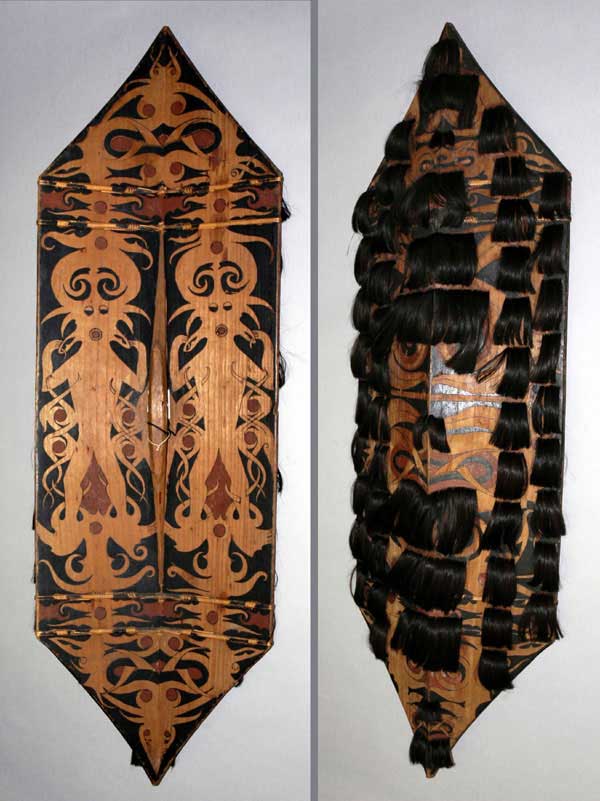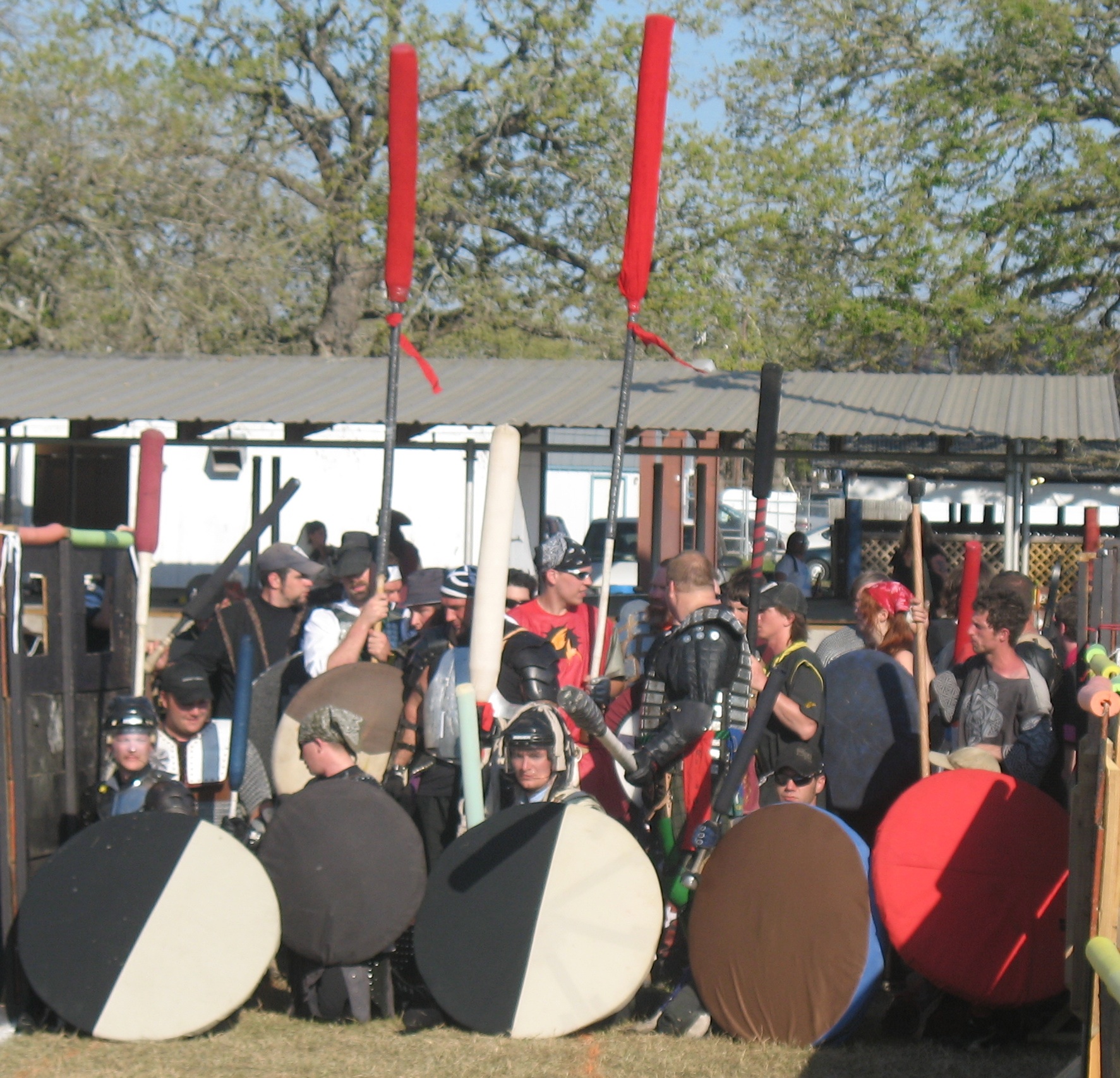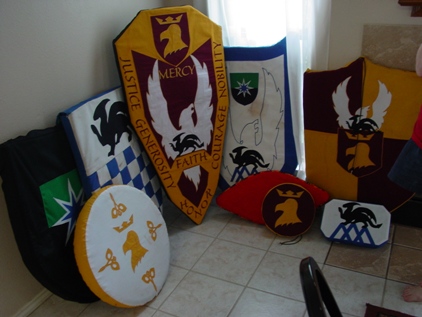Difference between revisions of "Shield"
(Sheilds) |
(Updated to V8 "Saucy" edition) |
||
| (6 intermediate revisions by 2 users not shown) | |||
| Line 1: | Line 1: | ||
==From the [[V8]] [[Rulebook]]== | ==From the [[V8]] [[Rulebook]]== | ||
[[Image:Sheildwallsw2007.jpg|thumb|A Shield Wall during a [[Battlegame]] at [[Spring War]] [[2007]]]] | [[Image:Sheildwallsw2007.jpg|thumb|A Shield Wall during a [[Battlegame]] at [[Spring War]] [[2007]]]] | ||
| − | Shields are used to block shots from [[weapons]] and are impervious to harm except from certain [[Magic and Abilities|abilities and magics]]. All shield measurements are the exterior surface area on a flat plane. | + | <onlyinclude>Shields are used to block shots from [[weapons]] and are impervious to harm except from certain [[Magic and Abilities|abilities and magics]]. All shield measurements are the exterior surface area on a flat plane. |
# Must not break or bend significantly during the course of combat. Rigid or easily breakable foam, or low-density foams, are inappropriate for all-foam shield construction. Some acceptable materials are: | # Must not break or bend significantly during the course of combat. Rigid or easily breakable foam, or low-density foams, are inappropriate for all-foam shield construction. Some acceptable materials are: | ||
#* Sturdy high-density [[foam]]. | #* Sturdy high-density [[foam]]. | ||
| Line 12: | Line 12: | ||
# Hard edges may not be exposed on any surface which can reasonably come into contact with another player or their equipment. | # Hard edges may not be exposed on any surface which can reasonably come into contact with another player or their equipment. | ||
# A player may only wield one shield at a time. | # A player may only wield one shield at a time. | ||
| − | # Must be gripped in a hand in order to be considered wielded. | + | # Must be gripped in a hand in order to be considered wielded. An open hand inside a shield handle is not enough to consider that shield wielded. |
#* A shield that is gripped in a hand may also have a support strap around the arm. | #* A shield that is gripped in a hand may also have a support strap around the arm. | ||
#* A blow that strikes a non-wielded shield strapped to a player, such as a shield slung across a back, is considered to strike the player as if the shield had not been there. | #* A blow that strikes a non-wielded shield strapped to a player, such as a shield slung across a back, is considered to strike the player as if the shield had not been there. | ||
| Line 19: | Line 19: | ||
# A medium shield is no larger than five square feet (30.28 inch diameter). | # A medium shield is no larger than five square feet (30.28 inch diameter). | ||
# A large shield is no larger than eight square feet (38.3 inch diameter). | # A large shield is no larger than eight square feet (38.3 inch diameter). | ||
| − | # | + | # Shield shapes may not cause confusion on the field. A shield cannot look like [[Armor]] or a [[Weapon]]. |
| − | # A shield may be tossed in a manner that keeps it (relatively) perpendicular to the ground. While in the air, such a shield is considered a terrain effect, though it is still vulnerable to things that would normally affect a shield (such as [[Fireball]] or [[Destruction Arrow]]). A shield may not be tossed into another player or their wielded equipment. | + | # A shield may be tossed in a manner that keeps it (relatively) perpendicular to the ground. While in the air, such a shield is considered a terrain effect, though it is still vulnerable to things that would normally affect a shield (such as [[Fireball]] or [[Destruction Arrow]]). A shield may not be tossed into another player or their wielded equipment.</onlyinclude> |
===Shields in history=== | ===Shields in history=== | ||
| Line 42: | Line 42: | ||
===Links=== | ===Links=== | ||
| − | |||
| − | |||
| − | |||
| − | |||
*[http://www.alonatwotrees.com/library/howto/how2shld.pdf How to make a Amt legal Sheild] by [[Vaargard]] | *[http://www.alonatwotrees.com/library/howto/how2shld.pdf How to make a Amt legal Sheild] by [[Vaargard]] | ||
*[http://www.theriversend.com/uploads/Fitz__Center_Grip_Shield_Tutorial.pdf how to make a center grip shield] by [[Fitz]] | *[http://www.theriversend.com/uploads/Fitz__Center_Grip_Shield_Tutorial.pdf how to make a center grip shield] by [[Fitz]] | ||
| − | ===== | + | *[https://docs.google.com/spreadsheets/d/1YJY-X4mEdy0mK87K404asTgJxPe86kGgfDDZ5b7pF_g/edit?usp=sharing Heater Shield Size Calculator] |
| − | * | + | |
| − | * | + | ====Materials==== |
| − | Check out the [[Amtgard Resources]] page for more information. | + | * Pelican Sleds - good, lightweight, sturdy |
| + | * Riva Sports: space saucer, snowsled - good, heavy duty | ||
| + | * Some shields are made entirely of [[Polyethylene Plank Foam]] | ||
| + | * Check out the [[Amtgard Resources]] page for more information. | ||
| + | |||
| − | |||
'''''See Also:''''' | '''''See Also:''''' | ||
| Line 63: | Line 62: | ||
[[Category:Rulebook Terms]] | [[Category:Rulebook Terms]] | ||
| − | [[Category: | + | [[Category:Amtgard Terms]] |
| − | + | [[Category:Equipment Rules]] | |
| − | [[Category:Equipment]] | ||
Latest revision as of 16:59, 18 September 2023
From the V8 Rulebook
Shields are used to block shots from weapons and are impervious to harm except from certain abilities and magics. All shield measurements are the exterior surface area on a flat plane.
- Must not break or bend significantly during the course of combat. Rigid or easily breakable foam, or low-density foams, are inappropriate for all-foam shield construction. Some acceptable materials are:
- Sturdy high-density foam.
- Plywood.
- High impact plastics.
- Aluminum.
- Must have an opaque, durable cover such as cloth or PlastiDip.
- The rim and face of the shield must be padded by at least 1” of closed cell foam.
- All-foam shields do not require any additional padding so long as the foam itself would be considered padding.
- Hard edges may not be exposed on any surface which can reasonably come into contact with another player or their equipment.
- A player may only wield one shield at a time.
- Must be gripped in a hand in order to be considered wielded. An open hand inside a shield handle is not enough to consider that shield wielded.
- A shield that is gripped in a hand may also have a support strap around the arm.
- A blow that strikes a non-wielded shield strapped to a player, such as a shield slung across a back, is considered to strike the player as if the shield had not been there.
- A small shield may be strapped to an arm instead of wielded in a hand.
- A small shield is between 36 square inches (6.8 inch diameter) and three square feet (23.45 inch diameter).
- A medium shield is no larger than five square feet (30.28 inch diameter).
- A large shield is no larger than eight square feet (38.3 inch diameter).
- Shield shapes may not cause confusion on the field. A shield cannot look like Armor or a Weapon.
- A shield may be tossed in a manner that keeps it (relatively) perpendicular to the ground. While in the air, such a shield is considered a terrain effect, though it is still vulnerable to things that would normally affect a shield (such as Fireball or Destruction Arrow). A shield may not be tossed into another player or their wielded equipment.
Shields in history
The oldest form of shield was a protection used to block attacks by hand weapons, such as swords, axes and maces or missiles like spears and arrows. Shields have varied greatly in construction over time and place. Sometimes shields were made of metal, but wood or animal hide construction was much more common; wicker and even turtle shells have been used. Many surviving examples of metal shields are generally felt to be ceremonial rather than practical, for example the Yetholm-type shields of the Bronze Age or the Iron Age Battersea shield.

Size and weight varied greatly, lightly armored warriors relying on speed and surprise would generally carry light shields that were either small or thin. Heavy troops might be equipped with large heavy shields that could protect most of the body. Many had a strap called a guige that allowed it to be slung over the user's back when not in use or on horseback. During the 14th-13th Century, the Sards or Shardana, working as mercenaries for the Egyptian pharaoh Ramses II, utilized either large or small round shields against the Hittites. The Ancient Greek hoplites used a round, bowl-shaped wooden shield called an aspis. Examples of German wooden shields c350 BC - 500 AD survive from Weapons sacrifices in Danish bogs. Free standing shields called pavises were used by medieval crossbowmen who needed protection while reloading.
The heavily armored Roman legionaries carried large shields (scuta) that could provide far more protection, but made swift movement a little more difficult. The scutum originally had an oval shape, but gradually the curved tops and sides were cut to produce the familiar rectangular shape most commonly seen in the early Imperial legions. Famously, the Romans used their shields to create a tortoise-like formation called a testudo in which entire groups of soldiers would be enclosed in an armoured box to provide protection against missiles.
Many ancient shield designs featured incuts of one sort of another. This was done to accommodate the shaft of a spear, thus facilitating tactics requiring the soldiers to stand close together forming a wall of shields.
In the early European Middle Ages, kite shields were commonly used; these were rounded at the top and tapered at the bottom. They were easily used on horseback and allowed easier leg movement when dismounted. As personal body armour improved, knight's shields became smaller, leading to the familiar heater shield style. Both kite and heater style shields were made of several layers of laminated wood, with a gentle curve in cross section. The heater style inspired the shape of the symbolic heraldic shield that is still used today. Eventually, specialised shapes were developed such as the bouche — which had a lance rest cut into the upper corner of the lance side, to help guide it in combat or tournament.
In time, some armoured foot knights gave up shields entirely in favour of mobility and two-handed weapons. Other knights and common soldiers adopted the buckler (origin of the term "swashbuckler"[1]). The buckler is a small round shield, typically between 8 and 16 inches (20-40 centimeters) in diameter. The buckler was one of very few types of shield that were usually made of metal. Small and light, the buckler was easily carried by being hung from a belt; it gave little protection from missiles and was reserved for hand-to-hand combat. The buckler continued in use well into the 16th Century.
In Italy, the targa, parma and rotella were utilized by common people, fencers and even knights. The development of plate armour made shields less and less common as plate armour eliminated the need for a shield. Lightly armoured troops continued to use shields after men-at-arms and knights ceased to use them. Shields continued in use even after gunpowder powered weapons made them essentially obsolete on the battlefield. In the 18th Century, the Scottish clans used a small, round shield called a targe that was partially effective against the firearms of the time although it was arguably more often used against British infantry bayonets and cavalry swords in close-in fighting.
In the 19th Century, non-industrial cultures with little access to guns were still using shields. Zulu warriors carried large lightweight shields made from a single ox hide supported by a wooden spine, these were called Ishlangu. This was used in combination with a short spear (assegai) and/or club.
Links
- How to make a Amt legal Sheild by Vaargard
- how to make a center grip shield by Fitz
- Heater Shield Size Calculator
Materials
- Pelican Sleds - good, lightweight, sturdy
- Riva Sports: space saucer, snowsled - good, heavy duty
- Some shields are made entirely of Polyethylene Plank Foam
- Check out the Amtgard Resources page for more information.
See Also:

